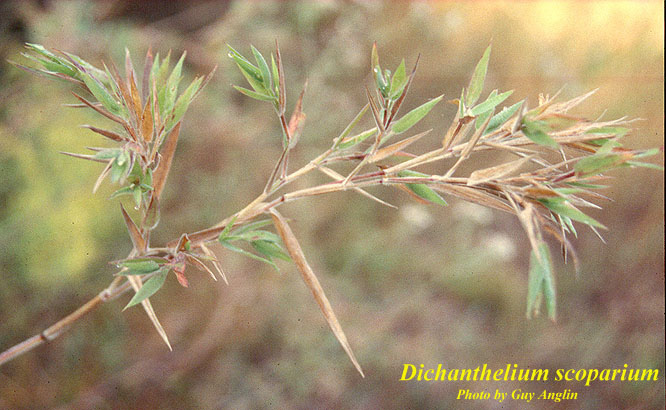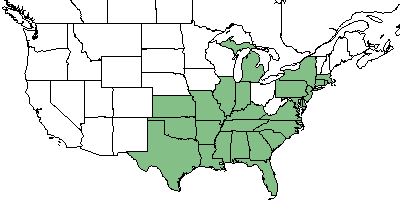Dichanthelium scoparium
Common Names: Velvet Panicum [1]; Velvet panic grass [2]; Velvet witchgrass
| Dichanthelium scoparium | |
|---|---|

| |
| Photo by the Atlas of Florida Plants Database | |
| Scientific classification | |
| Kingdom: | Plantae |
| Division: | Magnoliophyta - Flowering plants |
| Class: | Liliopsida - Moncots |
| Order: | Poales |
| Family: | Poaceae |
| Genus: | Dichanthelium |
| Species: | D. scoparium |
| Binomial name | |
| Dichanthelium scoparium (Lamarck) Gould | |

| |
| Natural range of Dichanthelium scoparium from USDA NRCS Plants Database. | |
Contents
Taxonomic Notes
Synonyms: Panicum scoparium Lamarck
Description
D. scoparium is a perennial gaminoid of the Poaceae family that is native to North America. [1] It can be identified by its dense and velvety pubescence that can be found on the internodes, sheaths, and blades of this plant, as well as the viscid band that is below the nodes.
Distribution
D. scoparium is commonly found across the southeastern United States, reaching as far west as Texas, and along the east coast up into New England.[1] It is also native to Mexico as well as the West Indies.[3]
Ecology
Habitat
Generally, D. scoparium can be found in moist sandy soils of ditches or woodland openings.[3] The bunchgrass prefers coarse soils and precipitation of 30-555 inches. It is commonly found in sandy woods, low areas, and disturbed regions. [1] Habitats that specimens were collected from include edges of mesic woodlands, moist loamy sands, creek bottoms, boggy pineland, deciduous woods, fresh water marsh, pine flatwoods, near brackish water, along creeks, and woods near ponds. [4]
Phenology
This species generally flowers from May until October.[3] D. scoparium has been observed to flower between May and July.[5] The basal rosette structure is produced during the fall and winter, the stems of the grass are produced during the spring.[1]
Use by animals
Wild turkeys and white tailed deer use the plant for winter forage. Small mammals and birds feed on the plant. [1]
Conservation and Management
The bunchgrass is considered an endangered species in Indiana. [1]
Cultivation and restoration
D. scoparium has been used as a revegetation source when working to restore a disturbed area.[1]
Photo Gallery
References and notes
- ↑ 1.0 1.1 1.2 1.3 1.4 1.5 1.6 1.7 USDA Plant Database
- ↑ Cipollini, M. L., et al. (2012). "Herbaceous plants and grasses in a mountain longleaf pine forest undergoing restoration: a survey and comparative study." Southeastern Naturalist 11: 637-668.
- ↑ 3.0 3.1 3.2 Weakley, A. S. (2015). Flora of the Southern and Mid-Atlantic States. Chapel Hill, NC, University of North Carolina Herbarium.
- ↑ URL: http://herbarium.bio.fsu.edu. Last accessed: June 2018. Collectors: States and counties: Florida (Wakulla, Calhoun, Bay, Gulf, Holmes, Liberty, Washinton, Leon, Jackson, Houston, Franklin, Nassau, Duval, Escambia, St. Johns, Madison), Arkansas (Saline, Pope), Georgia (Thomas, Oglethrope, Camden, Sumter), Louisiana (Oachita, Washington, St. Landry, Tangipahoa, Union), Virginia (Dinwiddie, Virginia Beach, Prine Edward), Mississippi (Jones, Smith, Harrison, Jackson, Pearl River, Hancock), Alabama (Montgomery), Texas (Freestone), South Carolina (Clarendon, Georgetown, McCormick), North Carolina (Nash), Oklahoma (Pushmataha),
- ↑ Nelson, G. PanFlora: Plant data for the eastern United States with emphasis on the Southeastern Coastal Plains, Florida, and the Florida Panhandle. www.gilnelson.com/PanFlora/ Accessed: 21 MAY 2018